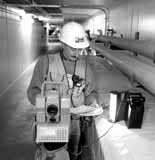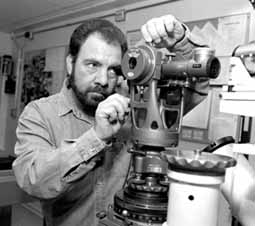 |
|
Measure for Measure by Mike Perricone
That's approximately 0.0078 inches, a measurement on the order of magnitude of the dot over the "i" in the word "inches" on this line of type. To physicists counting on the lab's new Main Injector accelerator, a tunnel movement of not much more than that distance can mean the difference between having beam and losing it, the difference between smooth running and downtime in Collider Run II.
"When the tunnel moves, the magnets move," said Shekhar Mishra, head of the Beams Division's Main Injector Department. "When the magnets move, that introduces an additional oscillation in the beam orbit around the machine. Depending on the size of that additional oscillation, your efficiency starts going down. If it's big enough in areas where the aperture of the beam pipe is smaller, you can scrape the sides of the beampipe and lose the beam."
Then the beams people lose no time.
"We call in the alignment guys," Mishra said.
In fact, "sea level" itself is a bygone concept among those whose business is taking the measure of the world around us. They now speak of the "geoid," the actual shape of the earth, and of "geoid height," the difference between the geoid and the ellipsoid that approximates the earth's shape. The ellipsoid adopted for use in North America is derived from the result of the 1866 evaluation by the British geodesist Alexander Ross Clarke. He apparently never set foot in North America, using measurements of meridian arcs in western Europe, Russia, India, South Africa, and Peru.
Because the earth changes, the ellipsoid is updated from time to time.
"The Clarke Ellipsoid was redefined in 1988, and that's what we base our geodetic work on," said Alignment and Metrology veteran Terry Sager. "It can be a little bit confusing, because the lab is originally set to 1929 data. There's a 0.17 meter change in height between those two vertical datums, and we include that in our documentation on our web site."
Around the site, giant concrete tubes with black markers are sunk 23 feet into the ground, attempting to reach the relatively immovable glacial till. Alignment and Metrology maintains a huge database of the monuments' relative positions. Thus, every point on the Fermilab site has two reference points: one to the network within the site established by the monuments, and one to the world at large. But each point also has two worldwide references, to 1929 data and 1988 data. See the emerging pattern?
Now translate those relative measurements to a precision machine inside a tunnel, such as the movable Main Injector. The beam pipe and the magnets have a specified alignment with each other, and with the tunnel walls and floor. The particle beam, which corkscrews through the evacuated beampipe at nearly the speed of light, is tuned to that specific alignment. Some very mundane influencesódirt, water, a dropped wrenchócan disrupt the whole scheme, prompting that call to the alignment guys.
Seasonal changes, and Dijak bolts
"We have one corrector for every quadrupole [steering] magnet in the Main Injector," Mishra said. "If we find the beam orbit changing, we have to run the correctors at greater strength. If we subsequently survey the magnets and find they've moved, we have them realigned and we can back off on the corrector magnets."
The seasonal effects of the creek running over the Main Injector tunnel are well documented. But there's another season that's nearly constant at Fermilab: the construction season. With nearby tunneling for the NuMI and MiniBooNE neutrino experiments, Alignment group leader Bob Bernstein can succinctly describe the impact on the Main Injector tunnel.
"If you take dirt off the top, the tunnel will rise," he explained. "If you put dirt back on the top, the tunnel will sink."
Both have occurred during the construction, as shown on the accompanying plot.
The vertical axis rises in increments of 0.000020 meters; think of each jump representing the dot on an "i." The horizontal axis represents stations around the Main Injector tunnel, so the end point comes back to the beginning. The sinusoidal curve shows the rise and fall of the tunnel itself, with the magnet locations represented in the points forming the jagged line.
When the points fall outside the acceptable bandwidth, it's time for adjustmentsóthe biggest being with a four-foot long open-end wrench.
The magnets are adjusted with leveling screws, like the ones beneath a stove or refrigerator. Of course, you're probably not using a laser to align your kitchen appliances. Then again, the earliest Fermilab tunnel and magnet alignments were based on lines drawn on the floor, in chalk or red paint, to set reference points.
When the KTeV (Kaons at the Tevatron) experiment was being set up around 1995, Dijak had an idea: sink bolts into the floor and attach eye-bolts to the walls to establish an alignment network. The system worked so well that "Dijak bolts" were incorporated into the design of the Main Injector tunnel.
In these newer areas, a control network is established using the laser tracker, adjusted to minimize errors, and then the final adjusted coordinates are used to align the magnets with the tracker of by optical tooling. The FMI and Recycler were aligned entirely with the laser tracker due to the tight specifications.
Using those reference points, aligning the Main Injector produces results within a few millimeters around the two-mile circle.
Tried-and-true optical instruments are the everyday tools of the craft.
"You get on two points with an optical instrument, read the scale and do the alignment," Sager said. "It's not sophisticated. It just works very well. It's probably what we use the most, day to day."
But laser trackers are critical in tight squeezes, such as in working with the collider detectors, where there is limited space and no clear line of sight. Alignment was two-dimensional until lasers gave rise to what is called the "total station device," producing three-dimensional coordinates on any given point. Laser trackers work on the interferometer principle, analyzing the interference between the outgoing and incoming light to calculate the distance to the reflective target placed on the instrument being measured.
MINOS, the Main Injector Neutrino Oscillation Search, is the biggest picture of all. The neutrino beam emerging from the tunnel at Fermilab must be accurate within 10 feet at its destination, the Soudan, Minnesota mineshaft 732 kilometers away and 2,600 feet below the surface. The MINOS tunnel at the lab must be aligned within a few arc-seconds, or 1/1,200 of a degree. The tunnel boring machine must be pointed within a few thousandths of a degree, in an excavation replete with rock and rubble, buffeted by blasting and subject to daily shifting in orientation.
The measurements are so delicate, that sightings down the tunnel shafts are disturbed by temperature variations in the air. To handle this tricky problem, the alignment group borrowed a surveying instrument using a system of inertial gyroscopes, from Stanford Linear Accelerator Center.
"We use instruments that only other accelerator laboratories would have," Bernstein said. "I wish we had these things ourselves, but SLAC is very cooperative and generous."
To link the end points of the long-baseline experiment, the alignment group is using satellite imaging.
"It's as cutting-edge as we can be, without being in the Defense Department," Bernstein said. "We'll also take sightings above the ground at Fermilab, project those references down to the tunnel, then extend them to Soudan, and get it right within 10 feet, or three meters out of 732 kilometers. We've been up to Soudan twice, and we'll go up during the detector construction to make sure we know that all the planes of the detector are surveyed correctly and in position."
The descent to the far detector will offer Bernstein and colleagues plenty of discussion time over how far they're going below sea level. The Soudan mineshaft has a very long elevator ride.
On the Web:
|
| last modified 3/16/2001 by C. Hebert email Fermilab |
FRLsDFx9eyfrPXgV
 When--not if--the earth moves, Fermilab's Alignment and Metrology Group can measure the effects to within two-tenths of a millimeter.
When--not if--the earth moves, Fermilab's Alignment and Metrology Group can measure the effects to within two-tenths of a millimeter.

 "You need one that long to supply enough torque," said Ed Dijak.
"You need one that long to supply enough torque," said Ed Dijak.
 The sophisticated V-Star three-dimensional digital photogrammetric system was used on the two 35-ton end muon system trusses for DZero ("The Big Picture," FERMINEWS, Vo. 23, No.4, Feb. 25, 2000). O'Sheg Oshinowo was the task manager for the project, taking the digital photographs from a cherry-picker. V-Star uses scanning software to resolve the centers of the reflector targets within 1/100 of inch.
The sophisticated V-Star three-dimensional digital photogrammetric system was used on the two 35-ton end muon system trusses for DZero ("The Big Picture," FERMINEWS, Vo. 23, No.4, Feb. 25, 2000). O'Sheg Oshinowo was the task manager for the project, taking the digital photographs from a cherry-picker. V-Star uses scanning software to resolve the centers of the reflector targets within 1/100 of inch.